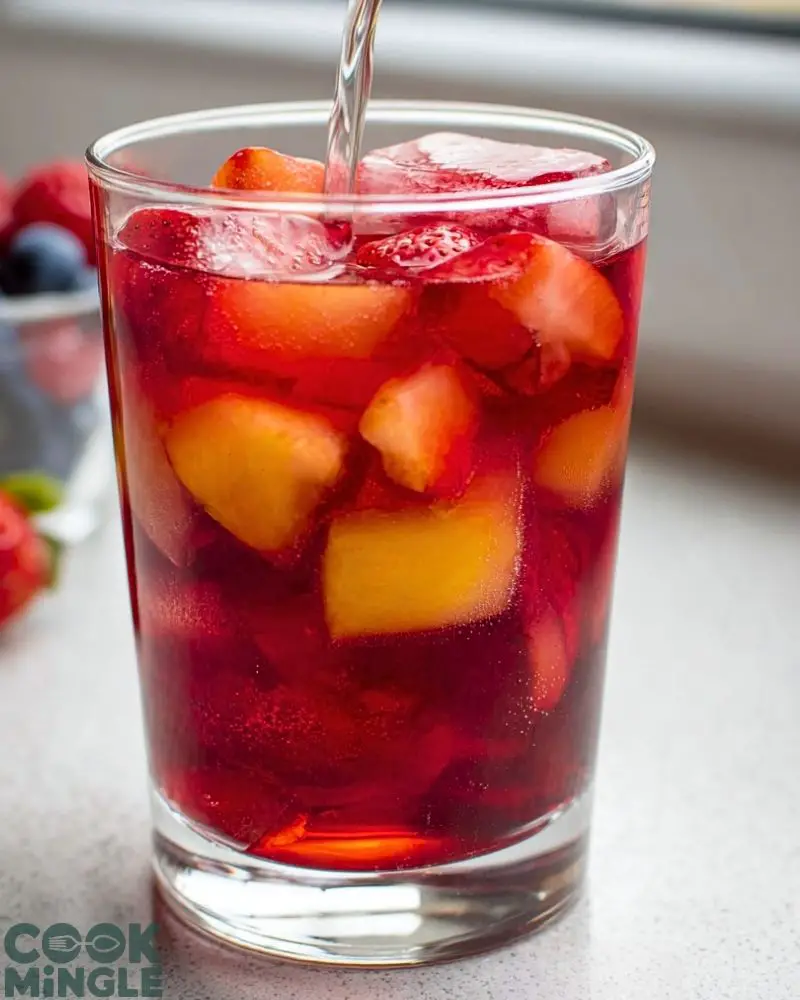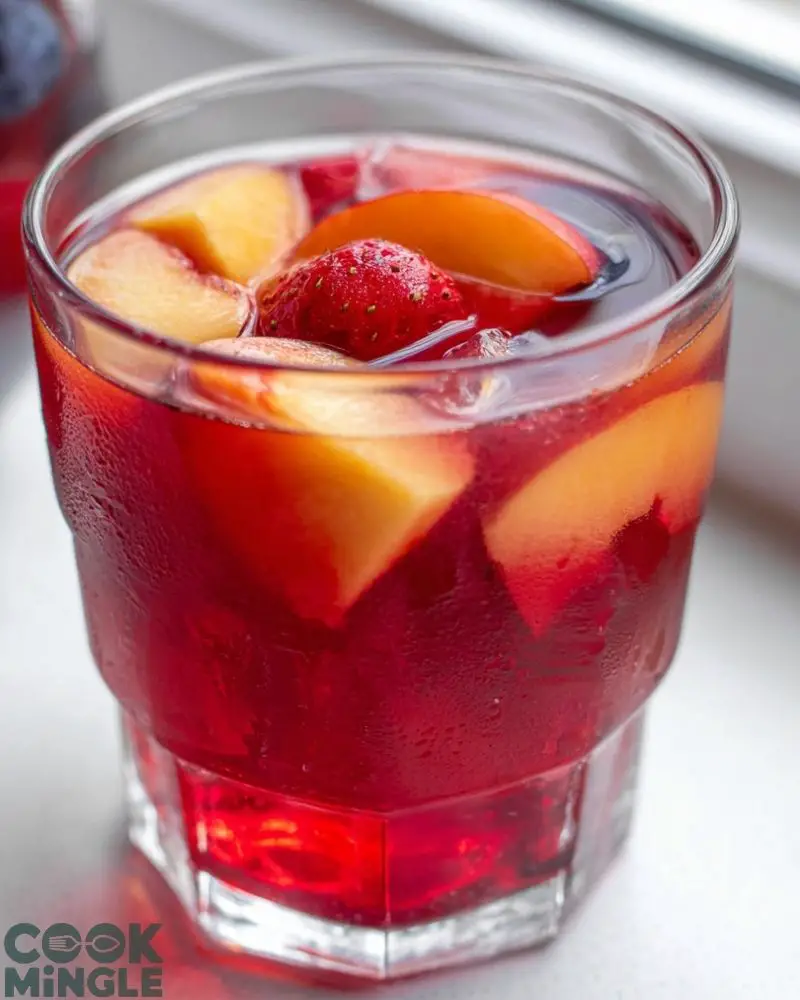I grew up drinking Kompot on hot summer afternoons, often poured from a chilled jug straight from the fridge. It wasn’t just a beverage — it was a seasonal tradition. Whether it was made with ripe cherries in June, strawberries and apricots in July, or apples and plums in early fall, Kompot always felt like a sip of sunshine. My grandmother would simmer fruits with just a touch of sugar, letting the natural sweetness shine through, and I’d hover nearby waiting for that first colorful glass.

Now, I make Kompot at home year-round. It’s simple, flexible, and endlessly refreshing. I especially love how it celebrates the beauty of fruit — whether fresh, frozen, or even slightly bruised. No fancy ingredients, just good old-fashioned flavor and vibrant color that instantly brightens any table. Whether you’re looking for a non-alcoholic drink to serve guests or just want to cool down with something wholesome, Kompot delivers every time.
Why You’ll Love This Kompot
- Naturally sweet and fruity: You control the sugar and spotlight the real fruit flavor.
- Zero preservatives: Unlike bottled juices, this is as pure as it gets.
- Versatile: Use whatever fruit is in season or what you have on hand.
- Budget-friendly: A great way to use overripe or excess fruit.
- Kid-approved and adult-loved: It’s colorful, refreshing, and hydrating.
- Can be served hot or cold: Warm for cozy evenings or chilled for summer heat.
- Easy to make in big batches: Perfect for parties, family dinners, or storing for later.
What Kind of Fruit Works Best for Kompot?
You can use just about any fruit in Kompot, and that’s part of its charm. I’ve made delicious versions with strawberries, cherries, apples, plums, apricots, pears, blackcurrants, blueberries — even rhubarb for a tangy twist. Softer fruits like peaches and berries give the drink a deep color and fragrance, while firmer fruits like apples and pears add body and a more subtle sweetness. Using a mix of fruits gives the best complexity, but even a single fruit can make a beautiful batch.
Frozen fruits work just as well and are great for when certain fruits are out of season. Just throw them into the pot straight from the freezer. Dried fruits can also be added for a deeper, richer flavor — dried apricots or prunes bring a pleasant intensity that balances well with fresh ingredients.
Options for Substitutions
Don’t be afraid to make Kompot your own. Here are some ways to personalize it:
- Swap the sweetener: Instead of white sugar, try honey, maple syrup, agave, or even stevia. Adjust to taste.
- Add citrus: A few slices of lemon or orange brighten the drink and cut through sweetness.
- Spices: A cinnamon stick, clove, or a piece of star anise can warm up the flavor — perfect for fall and winter.
- Herbs: A sprig of mint or basil can give a fresh lift, especially in a summer batch.
- Go unsweetened: If your fruit is super ripe, you might not need sweetener at all.
- Carbonate it: Mix it with sparkling water when serving for a fizzy version.
These small tweaks can turn a basic Kompot into something that fits your exact mood or season.
Ingredients for This Kompot
Mixed fresh or frozen fruit
The soul of any Kompot. Use whatever combination you love — strawberries, peaches, plums, cherries, apples, or even berries. Each fruit brings a unique color and sweetness. Aim for about 4–6 cups total.
Water
You’ll need enough water to cover the fruit and allow it to simmer gently. It also dilutes the natural sugars just enough for a light, drinkable result.
Sugar
This balances the tartness of some fruits and enhances the overall flavor. You can adjust the quantity depending on how ripe or sweet your fruit is.
Lemon slices or juice (optional)
Adds brightness and a gentle acidic note that keeps the flavor from being flat.
Spices (optional)
A cinnamon stick, a few cloves, or a piece of star anise can add complexity — especially for cooler months.
That’s it — just a handful of ingredients that turn into something beautifully refreshing.

Step 1: Prep the Fruit
Wash all your fruit thoroughly. If using fresh fruit, remove any pits, stems, or cores, and slice larger pieces like apples or peaches. If you’re using frozen fruit, there’s no need to thaw — just add them directly to the pot.
Step 2: Combine in a Pot
Place the prepared fruit into a large saucepan or pot. Add enough water to cover the fruit generously — about 8 to 10 cups for 4–6 cups of fruit. Stir in sugar to taste (start with ⅓ to ½ cup and adjust later).
Step 3: Add Optional Flavors
Drop in a few slices of lemon or a splash of lemon juice for brightness. You can also add a cinnamon stick, a couple of cloves, or a piece of star anise if you’d like a deeper flavor.
Step 4: Simmer
Bring the mixture to a boil over medium-high heat, then reduce the heat to low. Simmer gently for 20–30 minutes, or until the fruit softens and the liquid takes on a rich color.
Step 5: Taste and Adjust
Taste your Kompot. Add more sugar or lemon juice if needed. Let it simmer a few more minutes after any additions.
Step 6: Cool and Strain
Remove from heat and allow it to cool slightly. You can serve it with the fruit in the glass or strain it for a smoother drink. Chill in the fridge for at least 1 hour if serving cold.
Step 7: Serve and Enjoy
Pour over ice, garnish with fresh slices of fruit if you like, and enjoy a refreshing glass of homemade Kompot.
How Long to Cook the Kompot
Once everything is in the pot, the actual cooking time is short and gentle. Bring the mixture to a boil, then reduce the heat and simmer for 20 to 30 minutes. That’s usually enough time for the fruits to release their juices, soften, and infuse the water with vibrant flavor and color. If you’re using firmer fruits like apples or pears, you can go closer to 40 minutes. But don’t boil too hard or too long — you want a clean, light fruit flavor, not a jammy reduction.
Tips for Perfect Kompot
- Use ripe fruit: The riper your fruit, the better the flavor. It also means you can use less added sugar.
- Taste as you go: Start with less sugar and adjust once the kompot simmers. You can always add more but can’t take it out.
- Let it chill: Kompot tastes better after it cools and sits for a bit. The flavors meld beautifully in the fridge.
- Don’t skip the lemon: Even a tiny splash balances the sweetness and keeps the flavor bright.
- Strain if you like clarity: Some people love eating the softened fruit at the bottom, others prefer a clean glass — both are correct!
- Store in glass: If you’re refrigerating it, store kompot in a glass jar or bottle to maintain its fresh flavor and vibrant color.
Watch Out for These Mistakes While Cooking
- Overcooking the fruit: Boiling too long can break down the fruit completely, leaving the drink cloudy and the flavor dull. Simmer gently instead.
- Adding too much sugar early on: Different fruits release sweetness as they cook. Start with less sugar and taste toward the end.
- Skipping acid: Without a splash of lemon or orange, the kompot can taste flat or overly sweet.
- Not skimming foam: A bit of foam might rise as the fruit simmers. Skimming it off leads to a clearer, cleaner drink.
- Using unwashed fruit: Especially if you’re using peels or skins, always wash fruit well to avoid off-flavors or residue.
- Forgetting to cool before storing: Putting hot kompot straight into a sealed container can create steam buildup and alter the taste.
What to Serve With Kompot?
Grilled Meats
Kompot is the perfect sweet-tart companion to grilled chicken, pork chops, or sausages — especially during summer BBQs.
Savory Pastries
Pair with borek, empanadas, or meat pies. The fruity kompot balances the richness beautifully.
Pancakes or Crepes
Serve kompot alongside or even pour it slightly thickened over sweet or savory breakfast crepes.
Cheese Boards
Offer chilled kompot with a board of soft cheeses, nuts, and crackers for a refreshing contrast.
Roasted Vegetables
Surprisingly, a glass of kompot works well next to herb-roasted carrots, beets, or parsnips.
Rice Dishes
Whether it’s pilaf, biryani, or plain rice, kompot offers a bright, sweet counterpoint.
Eastern European Classics
It’s a traditional match with pierogi, cabbage rolls, or schnitzel.
Simple Tea Cakes or Biscuits
Kompot and a small slice of butter cake or biscuit is an effortlessly satisfying afternoon snack.
Storage Instructions
Kompot stores beautifully, which makes it ideal for making in large batches. After cooling to room temperature, transfer it to clean glass bottles or jars with tight-fitting lids. It will keep in the refrigerator for up to 5–6 days. If you strain out the fruit, it tends to last a little longer and stays clearer.
For longer storage, you can freeze it. Pour the cooled kompot into freezer-safe containers, leaving a bit of space at the top to allow for expansion. It will keep in the freezer for up to 3 months. Just thaw it in the fridge and serve chilled or reheated.
Estimated Nutrition
This will vary depending on the fruits used and how much sugar is added, but for a basic 1-cup serving of kompot made with mixed berries and a modest amount of sugar, here’s a general estimate:
- Calories: 80–120 kcal
- Carbohydrates: 20–28g
- Sugars: 18–25g
- Protein: <1g
- Fat: 0g
- Fiber: 1–2g
- Sodium: 0–5mg
- Cholesterol: 0mg
It’s naturally low in fat and contains small amounts of vitamins and antioxidants from the fruit. You can easily lower the sugar content to make it even lighter.
Frequently Asked Questions
Can I make kompot without any added sugar?
Yes! If your fruit is sweet and ripe, you can absolutely skip the sugar. Taste as it cooks and only add sweetener if needed.
Is kompot served hot or cold?
Both are correct. Serve it chilled over ice in summer, or warm it gently in winter with a cinnamon stick for a cozy touch.
Can I use dried fruit in kompot?
Definitely. Dried apricots, prunes, or raisins add depth and a natural sweetness. Just simmer them longer to soften fully.
How long does kompot last in the fridge?
Properly stored in a clean jar or bottle, kompot keeps well for about 5 to 6 days. Straining the fruit helps it stay fresh longer.
Can I reuse the cooked fruit?
Yes! You can blend it into smoothies, spoon it over yogurt or oatmeal, or serve it as a soft compote alongside desserts.
What if my kompot is too sweet?
Add a bit more water or a splash of lemon juice to balance it out. Chill and taste again before adjusting further.
Is kompot healthy?
Generally, yes. It’s hydrating and free of preservatives. You control the sugar, and it contains natural antioxidants from fruit.
Can I use sparkling water with kompot?
Yes — it’s a great idea! Add a splash of kompot to sparkling water for a refreshing, lightly fizzy mocktail.
Conclusion
Kompot is more than just a drink — it’s a celebration of seasonal fruit, tradition, and simplicity. It’s incredibly flexible, easy to make, and deeply satisfying whether served warm in winter or cold in the summer sun. I love that it turns humble ingredients into something beautiful and nostalgic, with flavors that adapt to any moment or mood. Once you try it, I have a feeling it’ll become a regular part of your kitchen too.

Kompot
- Total Time: 40 minutes
- Yield: 6–8 servings
- Diet: Vegetarian
Description
Kompot is a simple, naturally sweetened fruit drink that originated in Eastern Europe. Made by simmering fresh, frozen, or dried fruits in water with a bit of sugar and optional spices, it’s a refreshing, colorful, and wholesome beverage. It can be served hot or cold, making it perfect for any season.
Ingredients
4 cups mixed fresh or frozen fruit
8 cups water
0.5 cup sugar (adjust to taste)
3 slices lemon or 1 tablespoon lemon juice (optional)
1 stick cinnamon or 2 cloves or 1 star anise (optional)
Instructions
1. Wash and prepare all fruit, slicing larger pieces and removing pits or cores as needed.
2. Place fruit in a large saucepan and add water until fruit is generously covered.
3. Stir in sugar and optional lemon slices or juice.
4. Add any spices you’re using for extra flavor depth.
5. Bring the mixture to a boil, then reduce heat and simmer gently for 20–30 minutes.
6. Taste and adjust sweetness or acidity as needed.
7. Remove from heat, cool slightly, then strain if desired.
8. Refrigerate for at least 1 hour if serving cold. Enjoy over ice or gently warmed.
Notes
Calories: 100 kcal per cup
Carbohydrates: 24g
Sugars: 22g
Protein: 0.5g
Fat: 0g
Fiber: 1.5g
Sodium: 3mg
Cholesterol: 0mg
- Prep Time: 10 minutes
- Cook Time: 30 minutes
- Category: Beverage
- Method: Stovetop
- Cuisine: Eastern European
Nutrition
- Serving Size: 1 cup
- Calories: 100
- Sugar: 22
- Sodium: 3
- Fat: 0
- Saturated Fat: 0
- Unsaturated Fat: 0
- Trans Fat: 0
- Carbohydrates: 24
- Fiber: 1.5
- Protein: 0.5
- Cholesterol: 0

